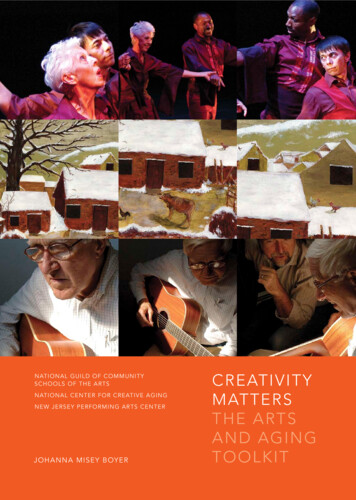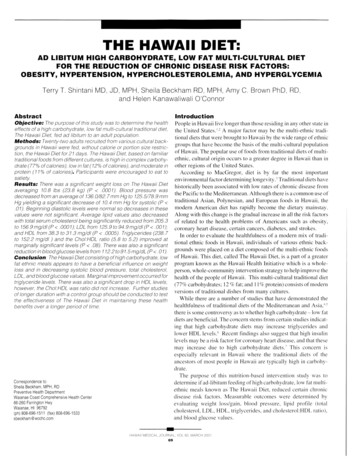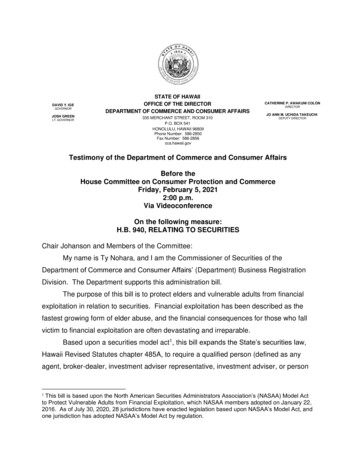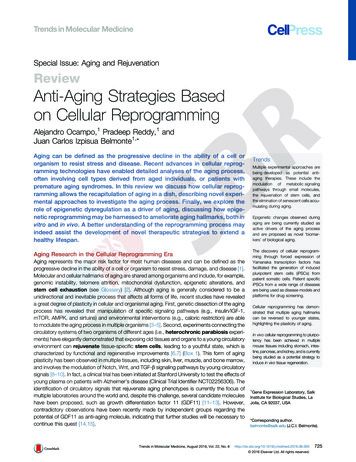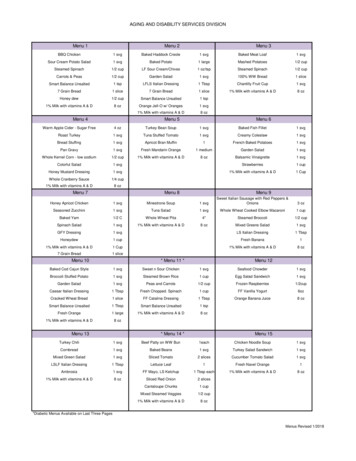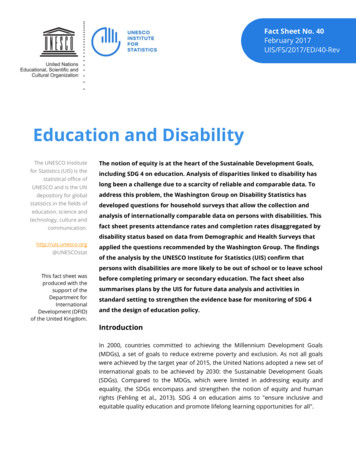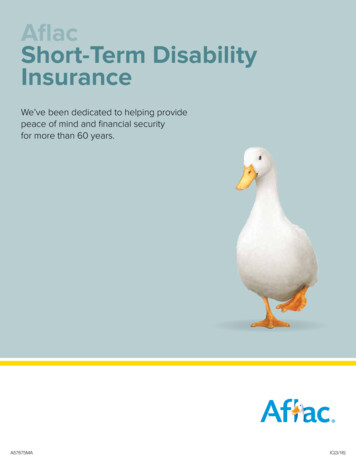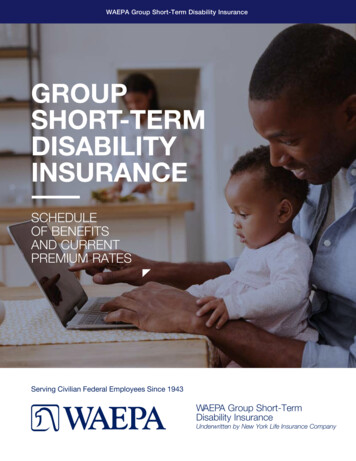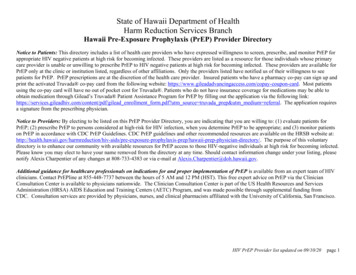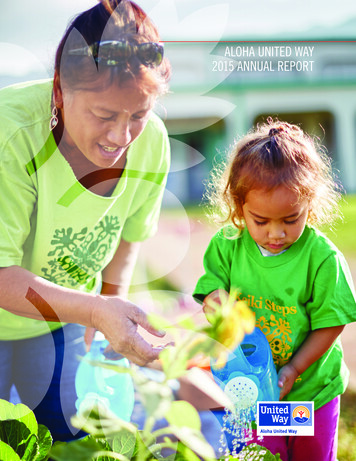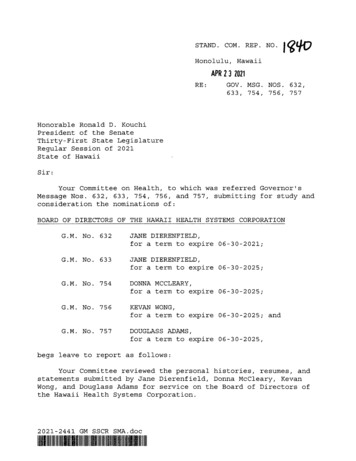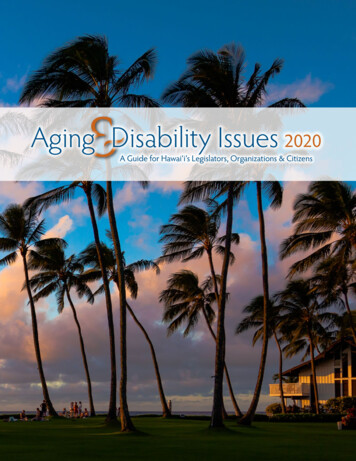
Transcription
&Aging Disability Issues 2020A Guide for Hawai‘i’s Legislators, Organizations & Citizens
Cover photo: Haleakala National ParkAging & Disability Issues 2020Sunset, Kaua‘i, Hawai‘iContributing AuthorsKevin Dusenbury, BSCraig Gima, BACullen Hayashida, PhDJohn G. McDermott, LSW, ACSW, MDivIan Ross, BAGary SimonEldon Wegner, PhDKathy Wyatt, RN, MSN, MBA, LNHASarah Yuan, PhDAuthors of personal stories acknowledged with respective stories where known.Hawai‘i Family Caregiver CoalitionBoard of DirectorsKevin Dusenbury, BSCullen Hayashida, PhDLyn MokuDavid NakamaejoCyndi Osajima, MPHGary SimonAudrey Suga-Nakagawa, MPHHelen WagnerFrancine Wai, MAEldon Wegner, PhDKathy Wyatt, RN, MSN, MBA, LNHA
TA B L E O F C O N T E N T S&Aging Disability Issues 2020A Guide for Hawai‘i’s Legislators, Organizations & CitizensSection 1Introduction & Overview . . . . . . . . . . . . . . . . . . . . . . . . . . . . . . . . . . . . . . . . . . . . . . . . . . . . . . . . . . . . . . . . . . . . . . . . . . . . . . . . . . . . . . . 3Section 2Keeping Kūpuna Healthy: Kūpuna Care; Aging & Disability Resource Centers;Healthy Aging Partnership Program; Long-Term Care Ombudsman Program . . . . . . . . . . . . . . . . . . . . . . . . . . . . . . . . . . . . . . . 6Section 3Aid to Caregivers: Kūpuna Caregivers Program; Paid Family Leave; Caregiver Education . . . . . . . . . . . . . . . . . . . . . . . . . . . . 12Section 4Alzheimer’s Disease & Related Dementias . . . . . . . . . . . . . . . . . . . . . . . . . . . . . . . . . . . . . . . . . . . . . . . . . . . . . . . . . . . . . . . . . . . . . . . 16Section 5Affordable Prescription Drugs . . . . . . . . . . . . . . . . . . . . . . . . . . . . . . . . . . . . . . . . . . . . . . . . . . . . . . . . . . . . . . . . . . . . . . . . . . . . . . . . . . 18Section 6Retirement Years: Hawai‘i Saves Program & Active Aging . . . . . . . . . . . . . . . . . . . . . . . . . . . . . . . . . . . . . . . . . . . . . . . . . . . . . . . . . 19Section 7Conclusion: A Path Forward . . . . . . . . . . . . . . . . . . . . . . . . . . . . . . . . . . . . . . . . . . . . . . . . . . . . . . . . . . . . . . . . . . . . . . . . . . . . . . . . . . . 21Section 8Information, Education & Research Resources . . . . . . . . . . . . . . . . . . . . . . . . . . . . . . . . . . . . . . . . . . . . . . . . . . . . . . . . . . . . . . . . . . . 241
About the Hawai‘i Family Caregiver Coalition, the Maui County Office On Aging, the Hawai‘i Pacific GerontologicalSociety, the Disability and Communication Access Board, and St. Francis Healthcare System of Hawaii.As caregiving touches everyone, themission of the Hawai‘i Family CaregiverCoalition (HFCC) is to improve the quality-of-life of those who give and receivecare by increasing community awarenessof caregiver issues through continuingadvocacy, education, and training.Over the years, the Hawai‘i Family Caregiver Coalition has supported our community by sponsoring the annual Aging& Disability Issues report, Family Caregiver Awareness Day at the State Capitol, and the annual HFCC Members andFriends Luncheon.For more information, please email GarySimon, President, at gsimon@aarp.org.The Maui County Office on Aging(MCOA) takes the lead role in agingissues on behalf of older persons inMaui County.As the designated lead agency at thelocal level, MCOA promotes and protects the well-being of elderly individuals in Maui County.For more information about MCOA,please call Deborah Stone-Walls, Director, at (808) 270-7774. MCOA’smailing address is: Maui CountyOffice on Aging, J. Walter CameronCenter, 95 Mahalani Street, Room20, Wailuku, Hawai‘i 96793.Organized in 1979, the Hawai‘i PacificGerontological Society (HPGS) is a notfor-profit organization whose mission is“to provide professionals and students inthe field of aging with vital information,workshops, networking, and scholarships to enhance the gerontology workforce; to support the creation of neededpolicies and programs; and to deliver excellent service to the aging population inHawai‘i and the Pacific.”If you are interested in pursuing thismission, you are invited to join theHPGS. Please visit the HPGS online atwww.hpgs.org or mail your inquiry to:P.O. Box 3714, Honolulu, Hawai‘i 96812.DISABILITY ANDCOMMUNICATIONACCESS BOARDThe Disability and Communication AccessBoard (DCAB) is a governor-appointedstate agency whose mission is to promotethe independence and civil rights of individuals with disabilities. DCAB supportsfamily and caregiving programs, as wellas universal and accessible design to allow individuals to live in the communityversus institutional settings.For more information, contact KirbyShaw, Executive Director, at dcab@doh.hawaii.gov, or at (808) 586-8121. Themailing address is: 1010 Richards Street,Room 118, Honolulu, Hawai‘i 96813.2St. Francis Healthcare System of Hawaii is one of the largest providers ofmulti-faceted care options for seniorsand caregivers in the Islands. Sponsoredby the Sisters of St. Francis of the Neumann Communities, it is the only Catholic healthcare system in Hawai‘i.St. Francis currently offers: Care navigation services Caregiving training and support Adult daycare In-home bathing & personalcare services Preschool Spiritual retreat center Hospice care in homes, nursinghomes, and at St. Francis HealthcareSystem’s inpatient facility inNu‘uanu; and Outreach to the homeless in Waianae.The health and wellness programs offered by St. Francis Healthcare Systemof Hawaii are rooted in a legacy of caringand compassion that began with St. Marianne Cope and the Sisters of St. Francis,who came to Hawai‘i to care for thosewith Hansen’s disease in 1883.Mailing address:St. Francis Healthcare System2226 Liliha Street, #227Honolulu, Hawai‘i 96817Email: info@stfrancishawaii.orgWebsite: stfrancishawaii.orgPhone: (808) 547-6500
SECTION 1IntroductionOverview&By Gary Simon, President, Hawai‘i FamilyCaregiver Coalition & Chair, Policy AdvisoryBoard for Elder AffairsThis 2020 issue of the Aging & Disability Issues report is the 15thannual publication that offers anoverview of legislative issues dealingwith aging, disability, caregiving, andlong-term care services and supports inHawai‘i. This report calls attention to thepriority issues that deserve the earnestattention of our lawmakers, advocates,and the public. It is a joint project ofthe Hawai‘i Family Caregiver Coalition(HFCC), the Policy Advisory Board forElder Affairs (PABEA), the ExecutiveOffice on Aging (EOA), the Hawai‘i Pacific Gerontological Society (HPGS), theHawai‘i Disability and CommunicationAccess Board (DCAB), the Maui CountyOffice on Aging (MCOA), and St. FrancisHealthcare System of Hawaii. Their support is gratefully acknowledged.This report has eight sections:Section 1 offers an overview of thereport, as well as some general observations of the political and economicchanges in Hawai‘i in 2020.Sections 2 through 6 describe the priority issues for the Legislature in the2020 session as designated by the majorgroups that advocate for the frail elderand disabled populations and their caregivers. The sections explain why theseissues are important, and provide background information concerning them.The six sections also discuss the specificbills that address these priority areas andtheir status at the time of this writing.Section 7, the Conclusion, provides abrief summary and a look ahead.Section 8 contains a listing of information, education, and research resourcesrelevant to aging and disability issuesthat may be helpful to those seeking additional information.3In addition, personal stories from caregivers regarding the issues they face andthe significance of public policies in enabling them to care for their loved onescan be found in the report. These storiesdemonstrate the emotional strains andrewards experienced by our beleagueredcaregivers and describe the difficultiesany of us could experience when facedwith aging or disability. These storiesprovide a human face to legislative issuesby illustrating how they are embodied inthe very human experiences of individuals and families.The Political Context of 2020An estimated 41 million family caregivers in the United States provided 34 billion hours of unpaid care to adult lovedones in 2017, according to AARP’s 2019Valuing the Invaluable report, the latestin an ongoing series of reports that lookat the contributions and needs of familycaregivers across the country. The reportestimates the approximately 34 billionhours caregivers contributed in 2017were worth 470 billion — more than(Continued on next page.)
SECTION 1 – continuedtotal out-of-pocket spending on healthcare in the U.S. that year ( 366 billion),and all money spent on paid caregiving in2016 (also 366 billion). The report notesthat family caregivers spent an averageof nearly 7,000 on caregiving expenses,such as transportation and home modifications in 2016. Research has shownthat family caregivers report higher ratesof loneliness than their non-caregivingpeers in mid-life and beyond.1Two Thousand Twenty is the year forus to build upon the foundation builtover the last 30 years. Family caregiver support is now firmly established asa national priority with the launch ofthe RAISE Family Caregiving Advisory Council, which acknowledges thateveryone’s quality-of-life is positivelyimpacted by providing support to ouroften emotionally, financially, andphysically taxed family caregivers. Established by the bipartisan RAISE Family Caregivers Act for which HFCC hasadvocated, the Council is charged withmaking recommendations for a nationalcaregiving strategy.The strategy will identify actions communities, providers, government, andothers are taking and may take to recognize and support family caregivers. Itwill include: Promoting greater adoption of person- and family-centered care in allhealthcare and long-term service andsupport settings with the person andthe family caregiver at the center ofcare teams Assessment and service planning (including care transitions and coordination) involving care recipients andfamily caregivers Information, education, training supports, referral, and care coordination Respite options Financial security and workplace issues.2The Hawai‘i Family Caregiver Coalitionwas pleased to work with the U.S. De4partment of Health and Human Servicesto advocate for the appointment of Deborah Stone-Walls, the Executive on Agingfor the Maui County Office on Aging, tothe Family Caregiving Advisory Council.Hawai‘i’s economy is expected to continue positive growth in 2020, with realGDP growth forecast at 1.2%. Accordingto the November 2019 Blue Chip Economic Consensus Forecasts, U.S. realGDP is expected to increase by 1.8%in 2020. 3 Thus, more resources may beavailable to address care issues, includingaiding family caregivers.The Older Americans Act (OAA) connects older adults and their caregivers toservices that help older adults age withhealth, dignity, and independence intheir homes and communities. In 2020,Congress must reauthorize this vital federal program that serves every community in the country.4 The OAA funds criticalservices that keep older adults healthyand independent — services like meals,job training, senior centers, caregiver
support, transportation, health promotion, benefits enrollment, and more.In May of 2019, Governor Jay Insleesigned into law a bill making the state ofWashington the first in the nation to create a state-run long-term care insurancebenefit to help its residents afford the highcost of services ranging from assistanceat home to nursing home stays. The LongTerm Care Trust Act will provide a lifetimebenefit of 36,500, indexed annually forinflation. Workers will be able to accesstheir benefits once they have paid intothe program for ten years. Some may beable to access benefits if they have workedcontinuously for three of the last six years.Beginning in 2022, employees would havejust over one half of one percent deductedfrom their wages to pay for the insurance.Benefits will be available to active employees and retirees starting in 2025.Here in Hawai‘i, Governor David Ige andthe State Legislature have supported innovations such as Kūpuna Caregivers, the firstprogram of its kind in the nation designedto provide working family caregivers withfinancial assistance to help pay for costsassociated with caring for their elders.The Governor and House and Senateleadership have committed to a packageof bills to make life better for our working families. Priorities include increasingthe minimum wage, tax relief, reducingthe cost of childcare, building affordablehomes, reducing homelessness, investingin agriculture and self-sufficiency, developing clean energy sources, sustainingour economy and culture, and playing ourpart in preventing climate change.6 Thesepriorities require enormous funding.However, investments in critical servicesfor our rapidly-aging population andthose with disabilities are also priorities.The efforts of the Legislature’s KūpunaCaucus, led by co-convenors Representative Gregg Takayama and Senator Sharon Y. Moriwaki, will be vital. In addition,aging and disability advocates must be5steadfast in ensuring that elected officialsat all levels of government are committedto our elders and those with disabilities.References1AARP. Family Caregivers Provide Billions of Hoursof Care Annually. fo-2019/family-caregiver-contribution-study.html. Accessed February 10, 2020.2Administration for Community Living. RAISE FamilyCaregiving Advisory Council. family-caregiving-advisory-council. Accessed February 10, 2020.3Department of Business, Economic Development &Tourism. Research & Economic Analysis. Outlook forthe Economy. 4th Quarter 2019 Report. omy/. Accessed February 10, 2020.4National Association of Area Agencies on Aging.Older Americans Act Reauthorization 2020. https://www.n4a.org/OAA. Accessed February 10, 2020.5AARP. Washington State Enacts Public Long-TermCare Insurance. o-2019/washington-long-term-care-law.html. Accessed February 10, 2020.6Capitol Connection. February 2020. ed February 10, 2020.
SECTION 2was in the EOA’s base budget, and the resthad to be determined annually throughspecial budget bills. Having the KūpunaCare program appropriately funded in thebase budget helps provide a consistent andstable program foundation, which is a necessary condition for meeting the increasingneeds of older adults throughout the state.Aging and DisabilityResource Centers (ADRCs)OKeeping Kūpuna HealthyBy Sarah Yuan, PhDChair, Legislative CommitteePolicy Advisory Board for Elder AffairsIn our rapidly aging society, a widerange of services has evolved to keepolder people healthy and active, andto support them so they can remain living in their own home and communityregardless of their ability level. Many ofthese service programs were initiated byfederal and state agencies, while otherswere developed at the local level throughprivate and public entities. Much of thefunding for these programs comes fromfederal and state governments, althoughin Hawai‘i, county governments also provide funding. This section will discussthree such programs: Kūpuna Care Aging and Disability ResourceCenters (ADRC) Healthy Aging Partnership(SB 2335/HB 1866)Kūpuna CareHawai‘i’s Kūpuna Care programwas established in 1999 to provide long-term services andsupports to frail and vulnerable adultsage 60 and over who lack access to oth-er comparable services. Kūpuna Careservices include adult daycare, assistedtransportation attendant care, case management, chore help, homemaker/housekeeping, personal care, and home-delivered meals. With an annual budget of 8.73 million, the state has supportedservices that enable older adults to remain in their homes and communities,delaying premature placement to expensive residential care facilities. Annualbudget funding is allocated to the Executive Office on Aging (EOA). The EOA thendistributes the funds to the Area Agencyon Aging (AAA) in each county, whichadministers the program and contractsfor services with private non-profit andfor-profit agencies. The services reachedalmost 9,000 older adults in FY19.As Hawai‘i’s older adult population increases rapidly with the most substantialincrease being those age 85 and over, ensuring adequate and economical care inthe least restrictive environment is crucial.Recognizing the critical role of the KūpunaCare program in the state’s long-term support service system, the Ige Administrationrequested 8.73 million in the FY20/FY21biennium budget for this program, whichwas approved in the 2019 Legislative Session. Until this year, only about half ( 4.85million) of Kūpuna Care program funding6lder adults, people with disabilities,and their families are often unprepared when the sudden onset of asevere health condition or sudden declinein function occurs. Once faced with theneed for long-term services and supports,families find it challenging to navigate thecomplexities of care systems. Aging andDisability Resource Centers (ADRCs) aredesigned to simplify the process of obtaining information and accessing support andservices. ADRCs also reduce the fragmentation of care systems, recognizing thatthe care needs of older adults and peoplewith disabilities are often similar. Througha single coordinated system, the development and implementation of ADRCs willensure access to high-quality care throughperson-centered services, which optimizeschoice and independence, encourages personal responsibility, and provides supportso individuals and their families can makeinformed decisions.Hawai‘i’s ADRCs are administered bythe Executive Office on Aging (EOA) andimplemented by each of the county AreaAgencies on Aging (AAA). The development of Hawai‘i’s ADRCs began in 2006when the EOA received a federal grant topilot the system and continued with thesupport from several federal grants andthe Hawai‘i State Legislature. Since 2016,the ADRC system has been implementedstatewide, with the operation customized by each AAA to meet county-specificneeds while adhering to a standard set offunctional criteria across all counties. TheADRC system offers a full range of information on long-term support programsand benefits; conducts the assessment onindividuals’ needs for services to maintainindependent living in the community; and(Continued on next page.)
EnhanceFitness at the Makawao Hongwanji MissionBack to the FarmBy Claudette MedeirosMaui County Office on AgingFalling off a ladder while picking avocadosduring the peak of avocado season in thesummer of 2013 was something BlancheIto never thought would happen. “Fallingwould cross my mind sometimes, but I neverthought it would happen,” she said. “Even at72-years-old, I could climb ladders. I didn’tthink I would fracture my back.” Blanche hadis a single point of entry for Kūpuna Careand Older Americans Act (OAA) services.In FY19, the ADRCs had nearly 53,000contacts, representing a 50% increase inits serving capacity from FY17. The ADRCslinked about 9,000 older adults to publicly-funded long-term services and supportprograms and provided assessment services to nearly 5,000 individuals.In the last Legislative Session, GovernorIge’s request to allocate 3.1 million toEOA’s base budget for the ADRC system wasapproved. It was a significant milestone forthe ADRC system, which went from having 55% (1.7 million) of its total budgetrely on annual special appropriation, toreceiving total funding in the base budget. With sustainable funding, the ADRCsystem will continue to grow in capacityand become fully functional according tofederal requirements, and be a dependableand reliable resource for long-term supportservices for Hawai‘i’s residents.been picking fruit from a ladder almost dailyfor decades. After her fall, Blanche was limited in what she could do physically as shewas experiencing great pain and neededto wear a back, body, and neck brace. Although she was mobile, exercise was limited.Blanche was unable to finish avocado seasonand needed to stay away from her farm.balance. She learned about EnhanceFitnessfrom her church and friends who were program participants. “My close friends told meabout EnhanceFitness and how they thoughtthe classes could help me, since they werefeeling better after a year in the classes,” sherelated. Skeptical about how the programcould help her, Blanche shared this information with her doctor, who agreed EnhanceFitness could be very beneficial physically,mentally, and socially. Blanche’s first class wasin October 2013, the start of persimmon season. “When I joined the program, my goal wasto heal my back and to get rid of my hunchback,” she said. “I needed to do something. Iwas suffering and persimmon season was going to start.” Blanche knew she needed to dosomething to help her back: “I couldn’t be onthe farm with my back like that—I needed toget back.” She has been diligently attendingEnhanceFitness classes three times a week atMakawao Hongwanji Mission ever since.Blanche felt her back was starting to finally healwhen she enrolled in Enhance Fitness, an exercise program designed for seniors to improvecardiovascular fitness, strength, flexibility, andBlanche credits her participation in the exercise program to getting back to her two acresof trees. “I have 70 trees to take care, two sea-The Healthy AgingPartnership ProgramThe Partnership offers two evidence-based programs:By Eldon L. Wegner, PhDThe Healthy Aging Partnership Program was founded in 2003 to improve the health status of olderadults by empowering residents to makehealthy decisions and engage in healthierlifestyles. The Partnership has receivedsupport from multiple funding streams,including grants and state and county budgets. It is a public-private partnership, withlargely public funding of private providerswho offer the programs to the public. TheUniversity of Hawai‘i Public Health Program successfully adapted evidence-basedhealth promotion and disease preventionprograms for Hawai‘i’s multicultural population, and has conducted continuousevaluation of the outcomes of the programsuntil last year.7(Continued on next page.)1. Better Choices, Better Health, a sixweek program on the self-management of chronic disease; and2. Enhance Fitness, an ongoing exerciseprogram designed for older adultsheld three-times a week.Better Choices, Better Health has hada total of 2,998 participants. The workshops complement medical-professional recommended treatment plans. Theparticipants learn skills to help managetheir health conditions and interact withtheir health care providers. A six-monthfollow-up evaluation found that participants had a decreased number of visits tophysician offices and emergency rooms,and a cost-savings analysis estimated anet saving of 655.81 per participant.Participants also reported increases in(Continued on next page.)
SECTION 2 – continuedBack to the Farm(Continued from page 7.)sons of picking fruit.” After six years of being anEnhanceFitness participant, Blanche does notclimb ladders like she used to but she is on herfarm almost daily. “I am now able to work onmy avocado and persimmon farm,” she said.Blanche believes she has become a healthier person since joining the exercise program.During the six years she has been an EnhanceFitness participant, Blanche has witnessedmany great achievements by her classmates,such as seeing an older participant’s balance,strength, and overall health improve to thepoint that “they walked around Disneyworldfor a week with no help at 80 years old.” Another classmate, “younger than me, was hit bya bus during their morning walk.” This personstrength exercise and aerobic exercise,and fewer symptoms of pain, fatigue, andshortness of breath.The EnhancedFitness Program served1,742 persons; 65% were age 70 to 89.After 16 weeks, participants reportedfewer falls and an increased number ofdays of being physically active. Improvements occurred in measures of physicalfunction, such as arm curls, chair stands,and up-and-go exercise. Funding for EnhanceFitess for 575 kūpuna was estimated to save 789,000 in healthcare costs.Prevention programs are always cost-effective with regard to chronic disease.Hawai‘i’s Healthy Aging Partnershipwas told EnhanceFitness participation wouldneed to be put on hold for at least 10 to 12months, but because of the strength theyhad built, they came back to class after only 6 months. These achievements have keptBlanche motivated to keep participating inthe program. “I know EnhanceFitness helpedme heal, and when I see the others get stronger and comeback from getting hit by a bus,it makes me want to continue with the program,” said Blanche, who feels EnhanceFitnessis the “perfect program” for her and many ofher classmates, whose ages range from 60 to90-plus years. “This program is designed forseniors like us,” she continued. “We’re all getting older and we need to support each other.” EnhanceFitness classes have given Blancheopportunities to meet and make new friends,as well as spend time with old friends. Ac-Program has received numerous national awards, including the 2013 award forExcellence in Multicultural Aging fromthe American Society on Aging.Legislative Support NeededThe Healthy Aging Partnership Programis one of the few state programs that implements evidence-based interventions.Systematic evaluations of program outcomes have been conducted, and documented evidence of cost-savings to thestate have been provided. However, consistent support is needed from the Legislature. Resources are desperately neededto not only continue the award-winningprogram, but to allow it to expand.8cording to Blanche, “We all need socialization;for some, our classes are the only socializationthey get. This year, she will be 79, and will keepgoing to the classes as long as they are offered.“It’s the only way I know I can keep healthy,”Blanche concluded. “Not only my balance andposture improved but my brain too with thememory exercises. EnhanceFitness has helpedme regain my posture, better my body andmy mind, and keeps me healthy enough tokeep me working my farm.”For more information about the Hawai‘iHealthy Aging Partnership, please visit www.hawaiihealthyaging.org or call the Executive Office on Aging at (808) 586-0100. To learn moreabout EnhanceFitness in Maui County, pleasevisit the Maui County Office on Aging onlineat www.mauicountyadrc.org, or call (808) 2707774 or toll-free at (808) 643-ADRC.No appropriations were passed for theHealthy Aging Partnership Program inthe 2018-19 budget year. As a result,the City and County of Honolulu had toclose its EnhancedFitness program sites.Kaua‘i and Maui received county funds tokeep some of their programs open. Due tobudget restrictions, a number of trainerswere let go, and the Executive Office ofAging suspend the program evaluationcontract with the Public Health Programat the University of Hawai‘i. Funding forthe 2019-20 fiscal year was restored, andthe Healthy Aging Partnership is rebuilding its staff and programs statewide.However, if the appropriation proposedin HB 1866 and SB 2335 fails to passthis session, the entire Healthy Aging Partnership program may end. Thehealth of our citizens would be negatively impacted and health care costs for thestate would increase. Thus far, SB 2335has cleared the subject matter committees and the Senate Ways and MeansCommittee, and HB 1866 has clearedthe subject matter committees in theHouse and is waiting to be heard in theHouse Finance Committee. The bills needto cross over and be heard by the otherbody in the coming weeks. We stronglysupport maintaining these programs.
Long-Term CareOmbudsman ProgramBy John McDermott, LSW, ACSW, MDivCompanion bills SB 2337 and HB1872 supporting the Long-TermCare Ombudsman Program (LTCOP) are of incredible importance. Variations of these bills have been introducedmultiple times before without success,but with the growing numbers of Hawai‘iseniors who need long-term care placement, it has never been more importantthan now to pass these bills.This study was done at a time when mostresidents were in nursing homes. Today’sresidents live in many more types of facilities: adult residential care homes, assistedliving facilities, community care foster family homes, and adult residential care homes.Additionally, in Hawai‘i they are spreadover six different islands. The logistics aretherefore more complicated than in 1995,and require greater staffing and funding.- 6 Adult Residential Care Homes with26 beds- Total: 33 Long-Term Care facilities;507 bedsMaui- 4 Nursing Homes with 459 beds- 1 Assisted Living Facility with 144 beds- 59 Community Care Foster FamilyHomes with 150 beds- 12 Adult Residential Care Homeswith 72 bedsThe purpose of these bills is to appropriate funds to the LTCOP for six full-time(6.0 FTE) ombudsman specialist positions, two each on O‘ahu and Hawai‘iIsland, and one each on Kaua‘i and Maui.The LTCOP protects our most vulnerablekūpuna, who are often hidden from sight.The LTCOP should not be confused withAdult Protective Services or the Department of Health’s Office of Health Care Assurance (the licensing agency). APS onlyinvestigates cases of abuse or neglect. TheDepartment of Health focuses mostly onannual inspections. They also investigatecomplaints, but the LTCOP is uniquelythere to proactively prevent problems;work with residents, family, and staff tomake facilities better; provide supportand protection to the residents; and investigate complaints and address concerns by visiting at least once per quarter.- 21 Community Care Foster FamilyHomes with 48 beds- Total: 76 Long-Term Care facilities;825 bedsHawai‘i IslandNumbers by IslandThe OAA mandates all res
brief summary and a look ahead. Section 8 contains a listing of informa - tion, education, and research resources relevant to aging and disability issues that may be helpful to those seeking ad - ditional information. In addition, personal stories from care-givers regarding the issues they face and the significance of public policies in en-
